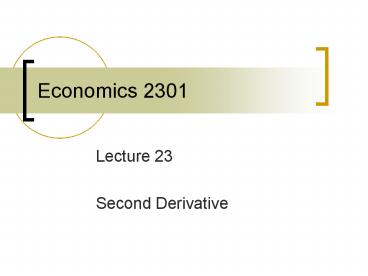Economics 2301 - PowerPoint PPT Presentation
1 / 16
Title:
Economics 2301
Description:
Production Theory Production Function Graph of our Production Function Two Utility Functions From microeconomics we know that more of a good is preferred to less of ... – PowerPoint PPT presentation
Number of Views:58
Avg rating:3.0/5.0
Title: Economics 2301
1
Economics 2301
- Lecture 23
- Second Derivative
2
Need for Second Derivative
- Several concepts in economics concern changes in
the marginal contribution of a variable. - Diminishing marginal Utility
- Increasing Marginal Cost.
- These involves changes in the marginal function
or the derivative of the original function.
3
Second Derivative
- The derivate of a function is itself a function.
- The derivative of the derivative of a function is
the functions second derivative.
4
Second Derivative
5
Interpreting the second derivative
Consider a function that explains the position of
a object at a point in time. The derivative of
that function with respect to time describes the
objects velocity. The second derivative
describes the change in velocity over time, that
is, the objects acceleration. Examples ICBM,
drag racer.
6
Example of second derivative
7
Drawing of Example
8
Economic Example
Consider a function that describes the natural
logarithm of the price level of an economy at any
moment in time. The derivative of that function
with respect to time represents the instantaneous
inflation rate. The second derivative with
respect to time represents the rate of change of
inflation. During a hyperinflation, inflation
accelerates for a period of time.
9
Production Theory
10
Production Function
11
Graph of our Production Function
12
Two Utility Functions
From microeconomics we know that more of a good
is preferred to less of a good (nonsatiation).
In addition, sometimes the assumption is made
that the extra benefit from consuming an
additional unit of a good is greater when overall
consumption of the good is lower than when it is
higher (diminishing marginal utility).
13
Two Utility Functions
14
Figure 7.4 Square Root Utility Function
15
Two Utility Functions
16
Figure 7.5 Logarithmic Utility Function































